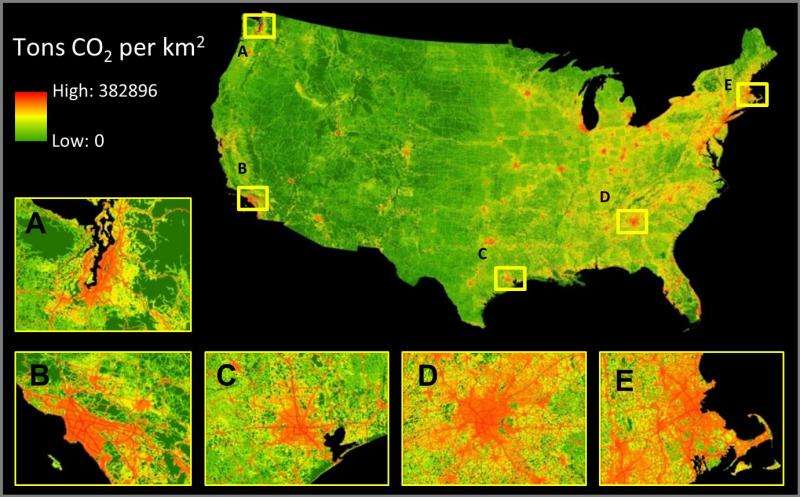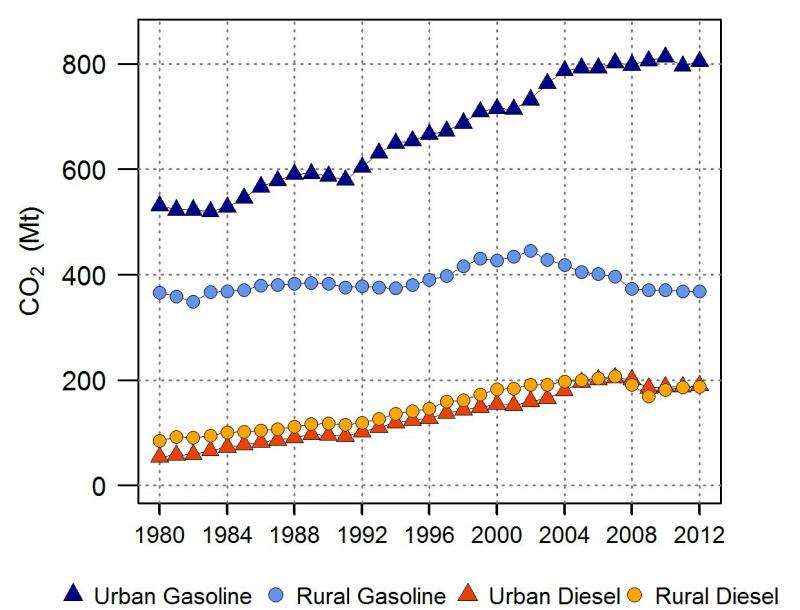Study of vehicle emissons will aid urban sustainability efforts

Vehicles churn out about 28 percent of the carbon dioxide (CO2) generated from fossil fuels in the United States, and their contribution keeps climbing, particularly in urban areas. But planners and policymakers have lacked a good handle on just how much CO2 is produced by vehicle travel in cities and suburbs, which is key knowledge for urban or statewide greenhouse gas control efforts. Now, Boston University (BU) researchers have created DARTE (Database of Road Transportation Emissions), a new nationwide data inventory that can help to provide this crucial information.
Constructed from the Federal Highway Administration's Highway Performance Monitoring System database of roadway traffic, DARTE brings together 33 years of data for CO2 emissions from roads across the entire country on a very tight scale—only one kilometer wide.
Early findings in DARTE highlight the ongoing shift in the U.S. towards urban traffic and emissions. "DARTE reveals that urban areas were responsible for 80 percent of the growth in vehicle CO2 emissions since 1980, and for 63 percent of total 2012 vehicle CO2 emissions," says Conor Gately, a graduate student in BU's Department of Earth and Environment, and lead author on a paper published today in the journal PNAS.
DARTE also has demonstrated that although planners and researchers often use population density figures to predict local levels of CO2 production by vehicles, such predictions may be wildly off.
Researchers in this field "have been crucially assuming that there's a linear relationship between population density and driving activity," notes Ian Sue Wing, associate professor and co-author on the PNAS paper. "We raise a huge red flag, saying no, that's not necessarily the way to go. In major urban areas, DARTE can differ from population-based estimates by as much as 500 percent."

Additionally, "the common wisdom is that we would expect vehicle emissions to decrease with the implementation of 'smart growth' policies that promote denser urban residential development," says Gately. "However, the most pronounced declines in per-capita emissions are only observed in cities that are already very dense such as New York and Boston, while for low- and medium-density cities the effects of densification are much more varied."
Better information is critical to improving efforts to minimize greenhouse gas release for a city or metropolitan area, notes Assistant Professor Lucy Hutyra, who is Gately's co-advisor and a co-author on the paper. "Although we don't have binding international or national policies yet, over 1000 U.S. cities have made pledges to reduce greenhouse gas emissions," she says. "But the large uncertainties in previous greenhouse gas emissions inventories have made it very difficult for a city to determine if it has actually reduced its emissions."
"For metropolitan areas that want to address CO2 emissions from their regional economy, knowing where they are is a prerequisite to doing anything about it," Gately agrees. "You can't affect what you can't measure."
In DARTE, various U.S. cities show dramatically different emission levels and trends. For instance, population density hasn't changed in Salt Lake City over time but the per-capita emissions have soared because the population is growing in the suburbs and the exurbs, but people still drive downtown, notes Sue Wing.
Providing a better baseline for studying vehicle emissions, DARTE will help to answer major policy questions in urban development, he emphasizes.
Experts disagree on how best to reduce on-road CO2 emissions, with "a fight between urban planners on one side, who focus on the design of the urban environment, and economists on the other side, who say, if you make something more expensive people will use less of it," Sue Wing says. "Do we tax driving and emissions, and make driving more difficult and more expensive? Or do we change people's environment, creating inducements or mandates that they will live closer to where they work, walk more, bike more and use more public transit? We don't know yet which approach will be more effective."
DARTE offers a powerful tool to address such questions because it covers the entire country, consistently and over the years from 1980 to 2012, says Hutyra. "Vehicle emissions have been the most poorly characterized sector for greenhouse gas emissions, and it's a large one," she notes.
"It's also the only sector that is still growing," Gately adds. "We have seen power plant and residential emissions of CO2 decline over the last decade, but transportation is much tougher to de-carbonize."
More information: Cities, traffic, and CO2: A multidecadal assessment of trends, drivers, and scaling relationships, PNAS, www.pnas.org/cgi/doi/10.1073/pnas.1421723112
The BU team emphasizes that raw data from DARTE is freely available for other researchers to download at dx.doi.org/10.7910/DVN/28999
Journal information: Proceedings of the National Academy of Sciences
Provided by Boston University



















